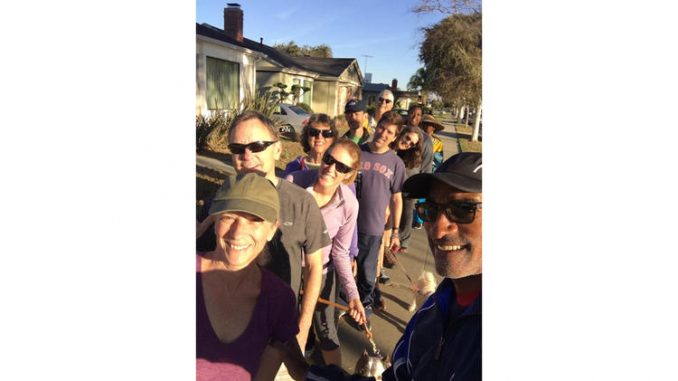
Angel Jennings, LA Times – It was the selfie that set Leimert Park talking.
There was DeMille Halliburton, his arm outstretched in the foreground, shooting a photo of the Saturday running group the African American entertainment industry insurer has long organized.
Behind him stood eight white neighbors, smiling under a sunny sky, a few holding on to their dogs’ leashes. Tucked in the very back were two black runners.
The photo Halliburton uploaded that day in October set off a storm of debate in Leimert Park, a middle-class, traditionally African American neighborhood.
The photo generated numerous comments on social media, with many expressing concerns about what they saw as the neighborhood’s changing demographics. For some blacks, the photo was a symbol of how they were losing clout in the neighborhood amid rising home values.
{snip}
Los Angeles’ African American population has been declining for more than two decades. Latinos now make up the majority in many working-class South L.A. neighborhoods. Leimert Park, nestled at the foot of the Baldwin Hills, has long been home to many of L.A’s African American elites.
{snip}
“It’s almost like Leimert Park is the last battleground,” said Earl Ofari Hutchinson, president of the Los Angeles Urban Policy Roundtable. “It’s the last piece of turf that African Americans can really call and really feel is their home. At this point in time, it’s being encroached upon.”
The running club photo does not exactly reflect the district’s demographics.
Today, Leimert Park continues to have one of the highest concentrations of black people in the city — 70%, down from the height of the 83% in the 1980s. White families currently make up about 2% of the neighborhood, a statistic in sharp contrast to the fleeting moment captured by Halliburton’s photograph.
{snip}
Halliburton said he was jogging with a neighbor last year at Leimert Park Village when a black man said loud enough for them to hear, “Get out of my neighborhood.”
The missive was directed at Halliburton’s neighbor, who is white.
Halliburton stopped, flabbergasted, and said, “Excuse me. This is our neighborhood too.”
The man went silent, Halliburton said.
“There are some real fears and anxieties about losing what people think they have,” said Halliburton, who added that he has been called an “Uncle Tom” and a “sellout” for “chum[ming] with the white folks.”
Halliburton found himself embarrassed, and in an unexpected position of having to comfort his white neighbor.
{snip}
Carl Pfirman, a recent arrival to Leimert Park who is white, said he has experienced similar hostile confrontations at Leimert Park Village and now skips that loop during the weekly run. He joined the running club, which now also welcomes walkers, in part because he wanted to be a good neighbor. But Pfirman said he was surprised by the uproar over the photo.
“I was pretty upset,” he said. “I don’t want to change the flavor of the neighborhood. I see my face there and I don’t want to be part of that, but I am. We need to talk. I don’t know what’s the solution.”
{snip}
The neighborhood was not always a haven for blacks. Up until the 1950s, the area was occupied by white families.
But they fled as black residents moved in.
Tens of thousands of whites left Leimert Park, Baldwin Hills and other South Los Angeles neighborhoods. The first wave left in the years after the Supreme Court invalidated white-only real estate covenants in 1948. Then another, larger exodus happened after the 1965 Watts riots.
The 1992 riots further battered Leimert Park. But in recent years, it has begun to see better times, and with that has come a growing sense of pride among black residents.
{snip}
The uproar over the photos has spilled over into packed community rooms where residents have candid conversations about gentrification and try to brainstorm ways to preserve the character of their neighborhood.
And the running group grew bigger and stronger. More people are coming out to join the club and Halliburton, the group’s leader, said it was adding a weekday meet-up.
{snip}
After the group’s runs, they meet at a Starbucks for frank conversation. On a recent Saturday, the members of the club talked about things like police use of force, politics and socioeconomic factors that have historically placed blacks at a disadvantage for acquiring wealth.
As he usually does during these talks, Pfirman leaned in and listened.